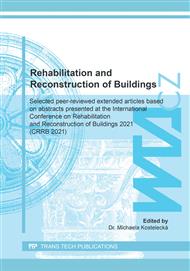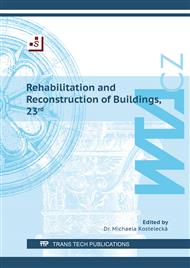[1]
MIRON L.E.R.D., KOLEVA D.A., Concrete Durability, Springer, ISBN: 978-3-319-55461-7, (2017).
Google Scholar
[2]
GU, J-D., FORD, T. E., MITCHELL, Microbiological corrosion of concrete (chapter 27), Uhlig´s Corrosion Handbook, John Wiley and Sons, ISBN: 0-471-15777-5, (2000).
Google Scholar
[3]
WASSERBAUER, R., Biologické znehodnocení staveb, ABF, ISBN: 80-86165-30-2, (2000).
Google Scholar
[4]
ROBERTS, D. J., NICA, D., ZUO, G., DAVIS, J. L., Quantifying microbially induced deterioration of concrete: initial studies. International Biodeterioration and Biodegradation, Volume 49, Pages 227-234, ISSN: 09648305, (2002).
DOI: 10.1016/s0964-8305(02)00049-5
Google Scholar
[5]
NOEIAGHAEI, T., MUKHERJEE, A., DHAMI, N., CHAE, S-R., Biogenic deterioration of concrete and its mitigation technologies. Construction and Building Materials, Volume 149, Pages 575-586, ISSN: 0950-0618, (2017).
DOI: 10.1016/j.conbuildmat.2017.05.144
Google Scholar
[6]
GU, J-D., FORD, T. E., BERKE, N. S., MITCHELL, R., Biodeterioration of concrete by the fungus Fusarium. International Biodeterioration and Biodegradation, Volume 41, Pages 101-109, ISSN: 09648305, (1998).
DOI: 10.1016/s0964-8305(98)00034-1
Google Scholar
[7]
LEDEREROVÁ, J., Biokorozivní vlivy na stavební díla, Silikátový svaz, ISBN: 978-80-86821-50-4, (2009).
Google Scholar
[8]
NĚMEC, M., MATOULKOVÁ, D., Základy obecné mikrobiologie, Masarykova univerzita v Brně, ISBN: 978-80-210-7923-6, (2015).
Google Scholar
[9]
KURDOWSKI, W., Cement and Concrete Chemistry, Springer, ISBN: 978-94-007-7944-0, (2013).
Google Scholar
[10]
PAGE, C. L., PAGE, M. M., Durability of concrete and cement composites, Wodhead publishing in materials, CRC Press, ISBN: 978-1-85573-940-6, (2007).
Google Scholar
[11]
JAVAHERDASHTI, R., Microbiologically Influenced Corrosion, Springer, ISBN: 978-1-84800-073-5, (2008).
Google Scholar
[12]
LEWANDOWSKI, Z., BOLTZ, J. P., Biofilms in water and wastewater treatment. Treatise on Water Science, Volume 4, Pages 529-570, (2011).
DOI: 10.1016/b978-0-444-53199-5.00095-6
Google Scholar
[13]
QAUTRINI, R., ESCUDERO, L. V., et al. Draft genome sequence of Acidithiobacillus thiooxidans CLST isolated from the acidic hypersaline Gorbea salt flat in northern Chile, Standards in Genomic Sciences, Volume 12, Pages 3-8, ISSN: 19443277, (2017).
DOI: 10.1186/s40793-017-0305-8
Google Scholar
[14]
, S., JIANG, Z., LIU, H., ZHOU, D., SANCHEZ-SILVA, M., Microbiologically induced deterioration of concrete – A Review, Brazilian Journal of Microbiology, Volume 44, Pages 1001-1007, ISSN: 1678-4405, (2013).
DOI: 10.1590/s1517-83822014005000006
Google Scholar
[15]
GEORGE, R. P., VISHWAKARMA, V., SAMAL, S. S., KAMACHI MUDALI, U., Current understanding and future approaches for controlling microbially influenced concrete corrosion: A review, Concrete Research Letters, Volume 3, Pages 491-506, ISSN: 2180-1371, (2012).
Google Scholar
[16]
KUBÁTOVÁ, A., Prezentace – rod Penicillium – typy konidioforů (https://www.natur.cuni.cz/biologie/botanika/veda-a-vyzkum/atlas-mikroskopickych-saprotrofnich-hub-ascomycota/3-06-eurotiales-pen-subg-furc.pdf) (27. 10. 2021).
Google Scholar
[17]
https://cs.ilovevaquero.com/zdorove/114042-aspergillus-niger-chto-eto-morfologiya-lechenie.html (27. 10. 2021).
Google Scholar
[18]
KARNEFELT, I., Cetraria (Parmeliaceae) and some related genera on the African continent, Bothalia, Volume 17, Pages 45-49, ISSN: 2311-9284, (1987).
DOI: 10.4102/abc.v17i1.1014
Google Scholar
[19]
https://www.nzplants.auckland.ac.nz/en/about/mosses/native-species/pottiaceae/tortula-muralis.html (27. 10. 2021).
Google Scholar



